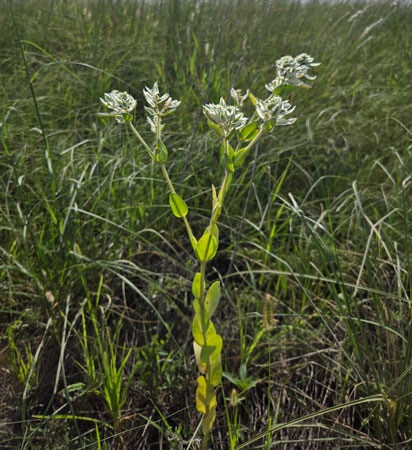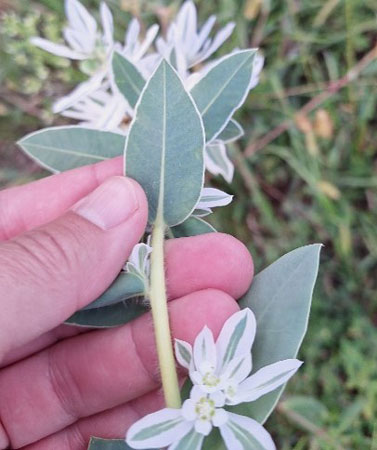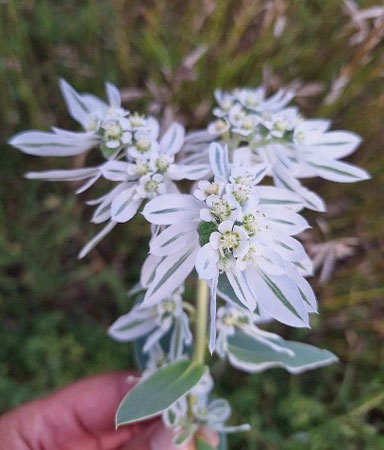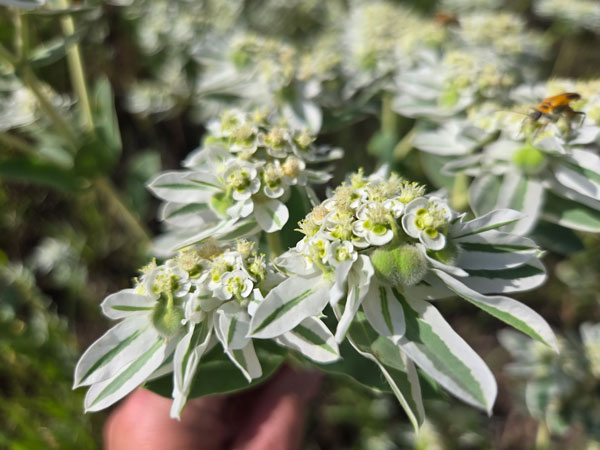The showy, white foliage of snow-on-the-mountain (Euphorbia marginata) is very noticeable in late summer, and you may see it right now on roadsides and in pastures. In fact, it is sometimes used as an ornamental. However, this plant can be toxic to humans and cattle. Honey produced by bees that have foraged on snow-on-the-mountain is called ‘jalapeno honey’ because it can burn when swallowed. Snow-on-the-mountain is a member of the Spurge family, which also includes poinsettias, toothed spurge, and hophornbeam copperleaf.
Ecology
Snow-on-the-mountain is a warm-season annual plant that is native to the Great Plains but has spread east of the Mississippi River and west of the Rocky Mountains. It is found throughout Kansas in disturbed areas of pastures, roadsides, or near streams. This plant prefers partially shaded areas but can grow in direct sun. It can thrive in a range of soil textures but is most abundant in limestone soils. Cattle generally will not eat snow-on-the-mountain because of the bitter taste. However, it may be consumed in hay, resulting in scours, weight loss, hair loss, and blisters. Mourning doves eat the seeds and are not harmed.
Identification
Stout, light green stems can reach 1 to 4 feet tall (Figure 1). The lower part of the stems is typically not branched and has no hairs. When the stem is broken, or the leaves are removed from the stem, a milky latex sap is released. This sap can be very irritating to the skin (Figure 2).

Figure 1. Snow-on-the-mountain growth habit. Photo by Jeanne Falk Jones, K-State Research and Extension.

Figure 2. White sap from broken stems. Photo by Jeanne Falk Jones, K-State Research and Extension.
The leaves are 1.5 to 4 inches long and 0.5 to 1.5 inches wide. They are oval to egg-shaped with a pointed tip and smooth margins. The leaves are attached directly to the stem at the base of the leaf (sessile). The lower leaves are mostly green and alternately arranged on the stem (Figure 3). The upper leaves are whorled (opposite where branches fork) and have wide, white margins.

Figure 3. An example of an upper leaf with a wide, white margin. Photo by Sarah Lancaster, K-State Research and Extension.
The small flowers on a snow-on-the-mountain plant can often be overlooked by thinking the white and green bracts near the top of the stem are the flower. However, the flowers are quite inconspicuous. One female flower and 35 to 60 male flowers are contained in receptacles about 3/8-inch wide that have 3 to 5 white “petals”, each with a green, oblong to kidney-shaped gland at the base. The receptacles are surrounded by large bracts with a broad band of white edging, sometimes entirely white (Figure 4). The bracts are modified leaf-like structures below the flower and form flat-topped clusters at the ends of the branches. Stems within the flowering branches are covered in hairs.

Figure 4. Bracts and flowers. Photo by Sarah Lancaster, K-State Research and Extension.
Rounded capsules contain the seeds. Capsules are about 0.2 inches long and usually covered in short hairs (Figure 5). Capsules are initially green, drying to dark gray. The seeds are spherical to egg-shaped, about 0.125 inch long, and dark gray. A single seed is contained in each of 3 capsule sections.

Figure 5. Capsules contain the seeds and are initially green and usually covered in fine, short hairs (right center of the photo). Photo by Jeanne Falk Jones, K-State Research and Extension.
Management
Snow-on-the-mountain is controlled by Group 4 herbicides such as DuraCor (aminopyralid + florpyrauxifen-benzyl), Grazon P+D (picloram + 2,4-D), and GrazonNext HL (aminopyralid + 2,4-D).
For more detailed information, see the “2024 Chemical Weed Control for Field Crops, Pastures, Rangeland, and Noncropland” guide available online at https://bookstore.ksre.ksu.edu/pubs/SRP1183.pdf or check with your local K-State Research and Extension office for a paper copy.
The use of trade names is for clarity to readers and does not imply endorsement of a particular product, nor does exclusion imply non-approval. Always consult the herbicide label for the most current use requirements.
Sarah Lancaster, Extension Weed Management Specialist
slancaster@ksu.edu
Jeanne Falk Jones, Multi-County Agronomist
jfalkjones@ksu.edu
Tags: weeds weed control World of Weeds snow on the mountain